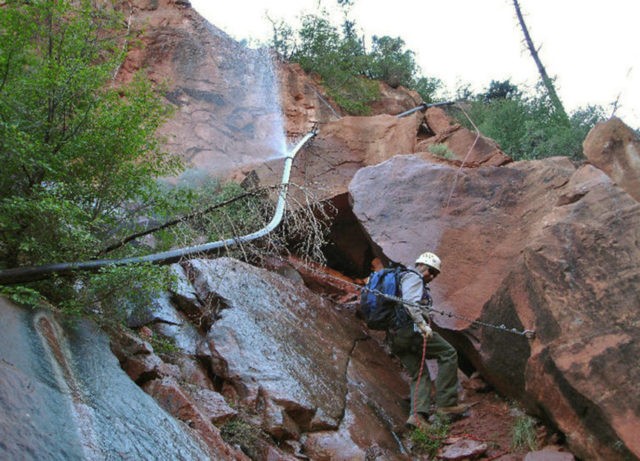FLAGSTAFF, Ariz. (AP) — Crews are drilling at the bottom of the Grand Canyon to test the idea of shifting the area where water is drawn to serve millions of people at the national park’s popular South Rim.
The park’s water supply comes from a natural spring that flows through 12.5 miles (20 kilometers) of pipeline. But the 1960s aluminum pipeline to the South Rim twists and turns around trails and through rocky terrain, frequently breaking and leaking. Each repair costs an average of $25,000.
Instead of pulling water from Roaring Springs, officials are looking to get it farther downstream in Bright Angel Creek before it enters the Colorado River. The switch would eliminate 5 miles (8 kilometers) of pipeline that is most prone to breakages and preserve the lush spring environment, the park said.
A helicopter flew in equipment this week to drill test and monitoring wells. A drill rig was being assembled Friday near a popular lodging by the creek known as Phantom Ranch, and the work will be completed over the next few days, stopping for mule traffic that shuttles people and supplies.
“We’ve gotten quite a bit of data, made some assumptions,” project manager Kris Provenzano said. “By bringing a drill rig down to Phantom Ranch, we’re going to be able to test those assumptions, make sure it’s not connected to the Colorado River and make sure the quality is sufficient.”
The $250,000 to $300,000 project is part of a larger study of how best to tackle the pipeline and ensure a consistent water supply for residents of Grand Canyon Village and the 6 million people who visit the national park each year. The South and North rims have storage tanks that could provide water during short-term repairs on the pipeline but longer-term fixes create more severe problems.
A recent series of breaks forced South Rim restaurants to switch to disposable dishes and utensils. Laundry and showers for campers were shut down, and RV dump-fill stations were not available. Water in storage tanks reached sustainable levels, the park said, but sinks in public restrooms will stay turned off this weekend, with hand sanitizer available.
A rockslide last year damaged the pipeline leading to the North Rim, which took $1.5 million to repair over two weeks. The lodge there canceled reservations, and water had to be hauled in for drinking and firefighting.
The focus, though, is on an overhaul of the South Rim extension of the pipeline.
Provenzano said crews will pump water from the test well over the next few days. If data is promising, the Grand Canyon would propose new pump stations and treatment plants built over two to three years.
Another option is replacing the entire pipeline with a more durable material along the same route. Grand Canyon officials have estimated the price tag at up to $120 million, partially funded by visitor entrance fees. It’s among the top priorities for the National Park Service.
The public would have a chance to weigh in on the options later this year.
Sandy Bahr of the Sierra Club said evaluating a change in where the water is drawn makes sense.
“It could potentially have less impact and could protect more of that spring environment, which we know the springs are big buckets of biodiversity,” she said. “They’re so important.”

COMMENTS
Please let us know if you're having issues with commenting.